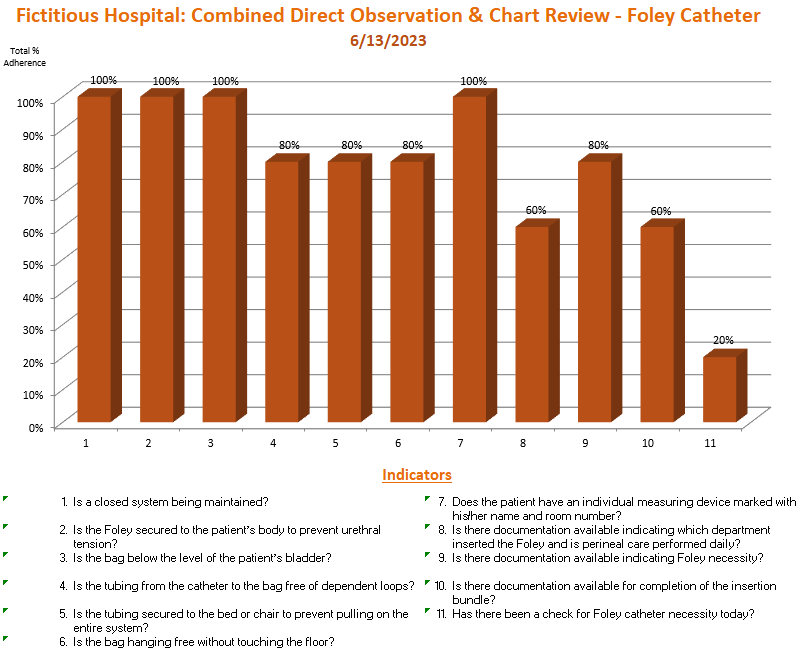An urban hospital in California worked with Health Services Advisory Group (HSAG), a Centers for Medicare & Medicaid Services (CMS) Hospital Quality Improvement Contractor (HQIC), to successfully decrease its catheter-associated urinary tract infection (CAUTI), central line-associated bloodstream infection (CLABSI), and Clostridioides difficile (C. diff) standardized infection ratios (SIRs).
The 384-bed hospital—with a diverse racial, ethnic, and impoverished patient population—had a 59.71 percent reduction in CLABSI SIR from baseline (10/01/20–09/30/21) to post-intervention (06/01/21–12/31/22). Additionally, the hospital achieved a 34.99 percent reduction in CAUTI SIR from baseline (10/01/20—09/30/21) to post-intervention (06/01/21–12/31/22) and a 60.40 percent reduction in C. diff SIR from baseline (01/01/19–12/31/19) to post-intervention (01/01/21–12/31/22).
During and after the pandemic, the hospital faced staffing shortages and challenges training new staff. To address these issues, the HSAG HQIC team encouraged the hospital to go back to the basics and shared the Centers for Disease Control and Prevention (CDC) National Healthcare Safety Network (NHSN) Getting Started Presentation and HSAG HQIC NHSN Survival Guide resources. HSAG hosted and shared webinars, including those from the Sepsis Alliance and CDC NHSN, offering a variety of educational support.

Support From HSAG HQIC Infection Preventionists
The hospital diligently worked with HSAG through meetings and emails with the hospital quality manager and performance improvement director to discuss and review the HSAG HQIC website infection prevention tools and resources. Partnering with hospital leaders, who have experience with performance improvement, made for effective communication in a short period of time. The hospital also had access to HSAG infection preventionists, who provided guidance on questions regarding NHSN resources and other tools available, to achieve its healthcare-associated infection (HAI) goals.
Recommended tools included HSAG’s HQIC Standardized Utilization Ratio (SUR) Calculator. The SUR Calculator is an Excel worksheet that allows the infection preventionist (or another user) to predict a SUR and plan interventions accordingly. The CAUTI and CLABSI Exploration Forms facilitate review of CAUTI and CLABSI events in a systematic manner and identify factors that may have contributed to the event. CAUTI and CLABSI Audit Tools (Excel workbooks) were shared to help the hospital monitor its use of indwelling urinary catheters and central lines. Graphs are automatically generated for necessity, maintenance, direct observation, and chart review. The data is audited by the hospital infection preventionist and shared with leadership and staff during meetings and sometimes posted in staff breakrooms. This data empowered the hospital to go back to basics with a focus on insertion, maintenance, and discontinuation practices. Based on CDC recommendations, insertion practices include documenting the department where insertion of the indwelling urinary catheter took place and completion of the insertion bundle. Maintenance practices include perineal care, patient necessity for an indwelling urinary catheter and documenting the necessity. Discontinuation practices include indwelling urinary catheter removal when necessity no longer exists.
Below is an example of fictitious hospital data and does not represent any particular hospital. The chart illustrates the total percentage adherence for 11 indicators for a Foley catheter.

Quality Improvement Innovation Portal (QIIP)
HSAG HQIC’s QIIP data application provides CAUTI, CLABSI, and C. diff data. The QIIP dashboard allowed this California hospital to compare itself to other local, state, and HSAG HQIC participating hospitals—as well as those with the same bed size, teaching and urbanicity status. The SUR Calculator is beneficial because it predicts the SUR so the hospital can implement interventions to decrease the SUR before it becomes a permanent part of CAUTI and CLABSI data available in the QIIP dashboard. The data source for the QIIP dashboard is NHSN.
Hospitals can use QIIP data to benchmark themselves against other hospitals. Countermeasures, such as readmissions and mortality, are also available in the QIIP dashboard. QIIP data are often shared with hospital board members and provide the opportunity to either identify gaps and determine what resources are needed or identify resources that helped the hospital succeed in its HAI efforts.
Hospital Quality Highlights
An additional resource is HSAG HQIC’s e-newsletter, Hospital Quality Highlights, for participating HQIC hospitals. This monthly resource assists with connecting hospital staff and leadership with pertinent information. Each newsletter focuses on a key CMS priority topic to expand progress toward better patient care and reduce patient harm.
Keys to Success
HSAG’s success can be replicated by taking the following steps:
- Keep fluent communication with hospital performance and quality improvement leaders.
- Ensure resources for preventing HAIs, such as CAUTI, CLABSI and C. diff are available to hospitals, such as audit and assessment tools.
- Employ infection preventionists to provide one-on-one support to hospitals, as needed.
For more information, visit HSAG HQIC.
This material was prepared by The Bizzell Group (Bizzell), the Data Validation and Administrative (DVA) contractor, under contract with the Centers for Medicare & Medicaid Services (CMS), an agency of the U.S. Department of Health and Human Services (HHS). Views expressed in this material do not necessarily reflect the official views or policy of CMS or HHS, and any reference to a specific product or entity herein does not constitute endorsement of that product or entity by CMS or HHS. 12SOW/Bizzell/DVA-1162-07/19/2023

